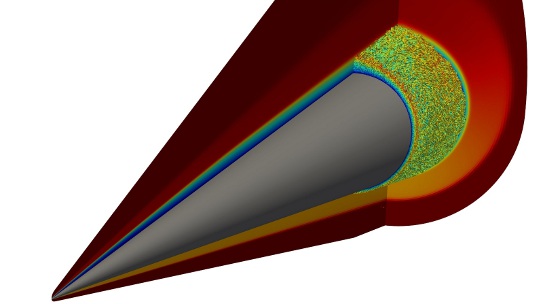 |
| December 13, 2022 | Volume 18 Issue 46 |
Designfax weekly eMagazine
Archives
Partners
Manufacturing Center
Product Spotlight
Modern Applications News
Metalworking Ideas For
Today's Job Shops
Tooling and Production
Strategies for large
metalworking plants
Rethinking DRAM: Sandia and Intel partner to develop new memory tech

Developed at Sandia National Lab, a high-fidelity simulation of the hypersonic turbulent flow over a notional hypersonic flight vehicle reveals unsteady loading on the back portion of the vehicle body. Accurately predicting these loads is critical to vehicle survivability. New research aims to improve memory performance characteristics used in simulation that can greatly benefit this and other mission applications. [Credit: Simulation by Cory Stack]
In pursuit of novel advanced memory technologies that would accelerate simulation and computing applications in support of the nation's stockpile stewardship mission, Sandia National Laboratories, in partnership with Los Alamos and Lawrence Livermore national labs, has announced a research and development contract awarded to Intel Federal LLC, a wholly owned subsidiary of Intel Corp.
Funded by the National Nuclear Security Administration's (NNSA) Advanced Simulation and Computing program, the three national labs will collaborate with Intel Federal LLC on the project.
"ASC's Advanced Memory Technology research projects are developing technologies that will impact future computer system architectures for complex modeling and simulation workloads," said ASC program director Thuc Hoang. "We have selected several technologies that have the potential to deliver more than 40 times the application performance of our forthcoming NNSA Exascale systems."
Sandia project lead James H. Laros III, a Distinguished Member of Technical Staff, said, "This effort will focus on improving bandwidth and latency characteristics of future memory systems, which should have a direct impact on application performance for a wide range of ASC mission codes."
"We are already anticipating what future platform challenges must be solved for the next generation," said Anil Rao, vice president and general manager of Intel's Systems Architecture and Engineering group. "We believe the Advanced Memory Technology program will help us generate support for the next decade of innovation."
"We are re-thinking fundamental aspects of how DRAM -- dynamic random-access memory -- is organized and coupled with compute platforms for breakthrough performance," said Intel Fellow Josh Fryman. "We intend to fundamentally advance computer system architecture by studying the hardest problems from scientists at Sandia, Lawrence Livermore, and Los Alamos national laboratories. Mainstream memory isn't designed for today's compute platforms, and this multi-year effort will help us to extract orders-of-magnitude performance gains from the basic DRAM design itself, thus enabling a new class of performance across all industry segments. We hope to see these innovations pushed into industry standards to lift the entire ecosystem."
The new contract is part of NNSA's post-Exascale Computing Initiative investment portfolio, which has the objective of sustaining the technology research and development momentum and strong engagement with industry that the initiative had started via its PathForward program. It aims to foster a more robust domestic high-performance computing ecosystem by increasing U.S. industry competitiveness in next-generation, high-performance computing technologies.
Simon Hammond, federal program manager for the ASC's Computational Systems and Software Environments program, said, "Intel and the ASC program have a long history of partnering to explore new technologies for our HPC system deployments. The project with Intel will provide important improvements in memory technologies that can support our production workloads."
"Investing in technologies that have the potential to increase the efficiency of our ASC mission applications is critically important in support of our stockpile stewardship mission," said Robert Hoekstra, senior manager of the extreme scale computing group at Sandia. "This collaboration shows great promise in supporting our future mission goals."
Source: Sandia National Laboratories
Published December 2022
Rate this article
View our terms of use and privacy policy
